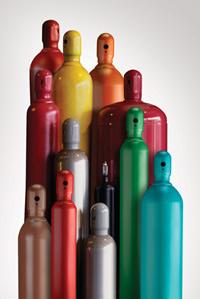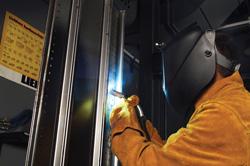- FMA
- The Fabricator
- FABTECH
- Canadian Metalworking
Categories
- Additive Manufacturing
- Aluminum Welding
- Arc Welding
- Assembly and Joining
- Automation and Robotics
- Bending and Forming
- Consumables
- Cutting and Weld Prep
- Electric Vehicles
- En Español
- Finishing
- Hydroforming
- Laser Cutting
- Laser Welding
- Machining
- Manufacturing Software
- Materials Handling
- Metals/Materials
- Oxyfuel Cutting
- Plasma Cutting
- Power Tools
- Punching and Other Holemaking
- Roll Forming
- Safety
- Sawing
- Shearing
- Shop Management
- Testing and Measuring
- Tube and Pipe Fabrication
- Tube and Pipe Production
- Waterjet Cutting
Industry Directory
Webcasts
Podcasts
FAB 40
Advertise
Subscribe
Account Login
Search
Helium: In short supply
Conservation tips, alternatives to help weld shops fight the crunch
- By Amanda Carlson
- March 11, 2008
- Article
- Consumables
Helium is an extremely unique and diverse element that plays a crucial role in many industries, including entertainment, medical, and manufacturing. According to the U.S. Department of the Interior's Bureau of Land Management (BLM), the welding industry accounted for 20 percent of U.S. helium consumption in 2006. But high demand and shrinking availability have caused helium prices to skyrocket, forcing welding shops to consider alternative gas blends and examine setup methods to conserve helium on the shop floor.
Helium is the most stable of all the elements. It does not burn or react with other elements, and it has the lowest melting and boiling points. It exists as a liquid at temperatures close to absolute zero, but as a gas otherwise. In contrast, most elements exist as solids close to absolute zero.
A recent article published in the October 2007 issue of CryoGas International states the shortage is expected to last for at least the next three years. A number of problems have affected crude feedstock supply at home and abroad, including supply interruptions due to normal plant maintenance and shutdowns because of severe weather. New crude sources in Algeria and Qatar have experienced technical problems, and these locations continue to be slow in reaching planned capacity utilization, the article states.
Steve Beckman, territorial sales manager of Rockford Industrial Welding Supply Inc., Rockford, Ill., does not expect relief until the end of 2009 or possibly into 2010. As a distributor of gases, including helium, Beckman estimates that the price of helium has gone up an average of 55 percent in the last year.
"We've had to go above and beyond our means to get helium. Normally, they [suppliers] would bring helium to us once a week. Now we're getting helium maybe twice a month and we're having to go outside of our area to pick it up twice a month," Beckman said.
The welding industry uses helium in shielding gas blends for stainless steel, aluminum, and laser welding applications. Laser welding, particularly CO2 laser welding, relies on helium because, unlike other gases, it does not reflect the laser beam's energy, said Kevin Lyttle, senior development associate for Praxair R&D, Tonawanda, N.Y. Helium also provides an aesthetically pleasing weld in stainless steel applications, which is particularly important for the food service and medical industries, he said.
"They want a weld that is very smooth and very flat. They want a weld that has very little spatter, and sometimes the color of the weld is important," Lyttle said.
Helium also is instrumental in aluminum welding because it increases the energy of the arc, Lyttle added.
So what can welding shops do to stay productive until the helium shortage ends?
Alternatives to Helium-containing Gas Blends
If the appearance of the weld is a high priority, Lyttle said, then helium-containing blends are still the best way to go. However, if the functionality of the weld is more important than its appearance, many alternatives to helium can be considered.
Lyttle said alternative gas blends for gas metal arc welding (GMAW) include argon with various percentages of CO2 and nitrogen or argon, CO2, and hydrogen. In gas tungsten arc welding (GTAW), blends of argon and hydrogen are suitable for stainless steel welding in place of argon/helium blends.
Hydrogen can be used only in shielding gases for stainless steel welding. It can help improve the visual appearance of the weld, even in the presence of CO2, and can remove oxide layers from the weld.
"Hydrogen also changes the flow characteristics of the weld pool. It breaks up oxide and allows the weld to flow more, which typically we relate to being able to weld faster, because the weld puddle will be more fluid and we can move faster," Lyttle said.
Adding nitrogen can enhance penetration characteristics of the arc and allows for some of the penetration characteristics that helium provides.
"Each gas is there for a reason. Sometimes one gas may be used to do away with the bad characteristics [of another]. There's a synergy between the different components," Lyttle added.
In aluminum welding applications, alternatives include argon or mixtures of argon and helium. Lyttle said these are the only two gases that will work; using hydrogen and nitrogen will only cause problems.
"Hydrogen reacts in the molten aluminum weld pool to form porosity. Nitrogen similarly reacts with some of the components that are in an aluminum welding wire to form a very brittle material that can interfere with properties of the weld."
Lyttle noted that for some applications, laser manufacturers have begun to look at alternative gas blends. While 100 percent argon is not acceptable, depending on the application, the laser beam power, and the material thickness, certain blends of argon and helium can be suitable. Lyttle said, in general, 100 percent helium levels can be substituted with a 25 percent argon/75 percent helium blend.
Conserving Helium
The idea of using alternative shielding gas blends tends to be a sticking point, especially for welding shops that have been using a certain percentage of helium in their shielding gas blends for a long period of time; are satisfied with results of their helium blends; or are reluctant to change. For weld shops that cannot substitute helium, they can look into using blends that have a lower percentage of helium or eliminate practices that result in helium waste, which include improper equipment assembly resulting in leaks, gas surge, and gas flows that are higher than necessary.
Lyttle said that helium is a very small molecule that can easily leak through small holes. Welders should check to make sure the welding system is assembled correctly, as well as use hard, screwed-on fittings instead of quick disconnects to help prevent leaks between the gas cylinder and the welding gun.
Welders tend to use flow rates that are greater than necessary for the welding process, thinking it will provide better protection against discoloration. Not only does this waste the shielding gas, Lyttle said, it can actually decrease the weld quality or appearance.
"If the flow of gas coming out of the welding gun is too great, the gas stream becomes turbulent and mixes in air from outside of the shielded area of the weld. This can create problems with the weld surface or with arc characteristics," said Lyttle.
Helium also is wasted during the gas surge that occurs each time an arc is initiated. If the regulator and flowmeter are set to supply, for example, 30 cu. ft. per hour of shielding gas, the first one or two seconds of an arc will produce a gas flow of approximately 150 cu. ft. per hour.
"When you multiply that [surge] by the number of starts each welder makes during a day, and then multiply that by the number of days in a week, it gets to be a significant number," Lyttle added.
An easy fix to such gas surges is to use a critical orifice—a round fitting with a small opening set to a specific size. These devices allow only a certain amount of shielding gas to pass through it, avoiding the waste associated with the blast of gas at each arc start-up.
Lyttle said welding shops that use helium-containing gas blends should analyze their applications and the requirements of their applications. Only then will they have an understanding of what they can do to stay productive throughout the shortage.
About the Author

Amanda Carlson
2135 Point Blvd
Elgin, IL 60123
815-227-8260
Amanda Carlson was named as the editor for The WELDER in January 2017. She is responsible for coordinating and writing or editing all of the magazine’s editorial content. Before joining The WELDER, Amanda was a news editor for two years, coordinating and editing all product and industry news items for several publications and thefabricator.com.
About the Publication
Related Companies
subscribe now

The Welder, formerly known as Practical Welding Today, is a showcase of the real people who make the products we use and work with every day. This magazine has served the welding community in North America well for more than 20 years.
start your free subscription- Stay connected from anywhere

Easily access valuable industry resources now with full access to the digital edition of The Fabricator.

Easily access valuable industry resources now with full access to the digital edition of The Welder.

Easily access valuable industry resources now with full access to the digital edition of The Tube and Pipe Journal.
- Podcasting
- Podcast:
- The Fabricator Podcast
- Published:
- 04/16/2024
- Running Time:
- 63:29
In this episode of The Fabricator Podcast, Caleb Chamberlain, co-founder and CEO of OSH Cut, discusses his company’s...
- Industry Events
16th Annual Safety Conference
- April 30 - May 1, 2024
- Elgin,
Pipe and Tube Conference
- May 21 - 22, 2024
- Omaha, NE
World-Class Roll Forming Workshop
- June 5 - 6, 2024
- Louisville, KY
Advanced Laser Application Workshop
- June 25 - 27, 2024
- Novi, MI


































